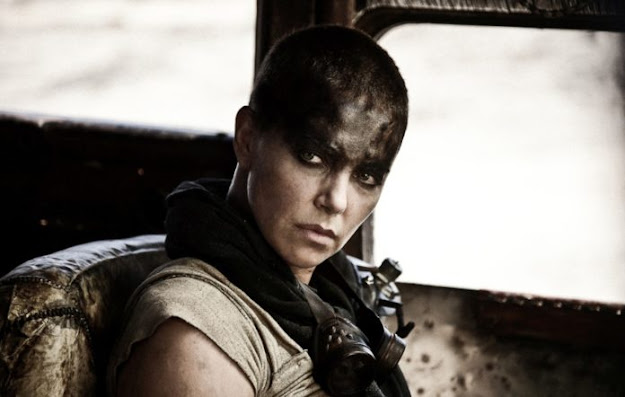Mad Max: Fury Road (a Review... of Sorts)
Image of Furiosa found here.
This film has been on my mind a lot lately for a few reasons. One, it's one of my top 10 favorite films. Two, I just read a really good interview with the cast in the NY Times from May 2020. Three, I revisited the soundtrack and it still ROCKS. Oh, and four, the world is in the midst of a giant crisis so why not turn to post-apocalyptic film as a distraction?
Another reason this film is dear to me is that I presented a paper on it at my first and only professional, academic conference in 2018. The timing was poor for a venture like this because I was in the midst of writing my master's thesis and took time away from it to drive to Indianapolis with my husband and attend a pop culture conference (which was amazing and fun). We ended up coming home a day early due to impending deadlines on my end and our general homesickness for our cats. My presentation was okay. I went after a woman presenting on The Walking Dead and the majority of the audience (minus my husband and a friend) were there to hear her paper. First time jitters also kicked in and I kept getting my feet tangled in the absurdly long tablecloth on the presenter's table. I had practiced reading my paper standing up, never knowing that sitting would be the preferred mode. Oh well, live and learn.
Mad Max: Fury Road was hyped a great deal prior to it actually opening in theaters. I saw it in theaters and loved it, even though I had only seen half of Thunderdome and Road Warrior (I have since seen all three original films multiple times). What is amazing but perhaps far from surprising is the intense backlash the film received from primarily male fans. Most probably expected a shot for shot remake of Mel Gibson's iconic role. What they received instead was a strong critique of toxic masculinity and a hero who is female. The patriarchy and men who operate through toxic masculinity have not only destroyed the world and its resources, they have built a hierarchy from the ashes to serve their own ends. Without going into great detail, my conference paper read the film through an eco-feminist lens to explore how it advances the notion of world reclamation through its female characters.
What perhaps fans and viewers who reviled the film failed to respond to was the deliberate process George Miller had for the making of this film. In the NY Times article, it details the failed attempts that eventually culminated into this iteration of the film--starting with Mel Gibson back in the role of Max, then shutting down production due to rain and flooding, to this final product born out of the intense conditions cast and crew lived and worked under in Namibia and the graphic novel-esque feel of the script itself. Miller brought in Eve Ensler (famous for the Vagina Monologues) to work with the actresses playing Immortan Joe's wives in order to help them fully grasp their characters' tenuous positions as child-bearers for a desert despot. Miller's wife edited the final cut of the film and her gaze helps to undoubtably shape an already nuanced and thoughtful film. The film makes it clear that women are the ones who will reclaim the damaged world and help rebuild it into something better.
In closing, I highly recommend this film. It's a wild, amazing visual experience. If you have a chance, watch it in its original format and then in the special edition black and chrome just once--it highlights the devastating carnage of a post-apocalypse in a way few films have ever done (in my humble opinion). There is violence, yes. But if you are worried about language, there is no swearing in the film (other than made up words). Take a chance on this film and experience the power and beauty of Miller's vision.



Comments
Post a Comment